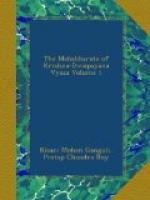’Lomasa said, ’It is even so, O thou of powerful arms! The saints of the highest order thus behold all the regions. Behold this holy Saraswati here, thronged by persons who look upon her as their sole refuge. O most praise worthy of men! having bathed here, thou wilt be free from all thy sins. O Kunti’s son! here the celestial saints performed sacrificial rites of Saraswata king: and so did the saints and the royal saints. This is the altar of the lord of beings, five yojanas in extent on all sides round. And this is the field of the magnanimous Kurus, whose habit it was to perform sacrifices.’”
SECTION CXXX
“Lomasa said, ’O son of Bharata’s race! If mortals breathe their last at this spot, they go to heaven. O king! Thousands upon thousands of men come to this place to die. A blessing was pronounced on this spot by Daksha, when he was engaged in sacrifice here, (in these words), ’Those men that shall die at this spot shall win a place in heaven.’ Here is the beautiful and sacred river, Saraswati, full of water: and here, O lord of men, is the spot known as Vinasana, or the place where the Saraswati disappeared. Here is the gate of the kingdom of the Nishadas and it is from hatred for them that the Saraswati entered into the earth in order that the Nishadas might not see her. Here too is the sacred region of Chamashodbheda where the Saraswati once more became visible to them. And here she is joined by other sacred rivers running seawards. O conqueror of foes, here is that sacred spot known by the name of Sindhu—where Lopamudra accepted the great sage Agastya as her lord and, O thou whose effulgence is like unto that of the sun, here is the sacred tirtha called Prabhasa, the favoured spot of Indra and which removeth all sins. Yonder is visible the region of Vishnupada. And here is the delightful and sacred river, Vipasa. From grief for the death of his sons the great sage Vasistha had thrown himself into this stream, after binding his limbs. And when he rose from the water, lo! he was unfettered. Look, O king with thy brothers at the sacred region of Kasmeera, frequented by holy sages. Here, O scion of Bharata’s race, is the spot, where a conference took place between Agni and the sage Kasyapa, and also between Nahusha’s son and the sages of the north. And, O great prince, Yonder is the gate of the Manasasarovara. In the midst of this mountain, a gap hath been opened by Rama. And here. O prince of prowess incapable of being baffled, is the well-known region of Vatikhanda, which, although adjacent to the gate of Videha, lieth on the north of it. And O bull among men, there is another very remarkable thing connected with this place,—namely, that on the waning of every yuga, the god Siva, having the power to assume any shape at will, may be seen with Uma and his followers. In Yonder lake also people desirous of securing welfare to the family, propitiate with sacrifices the holder




